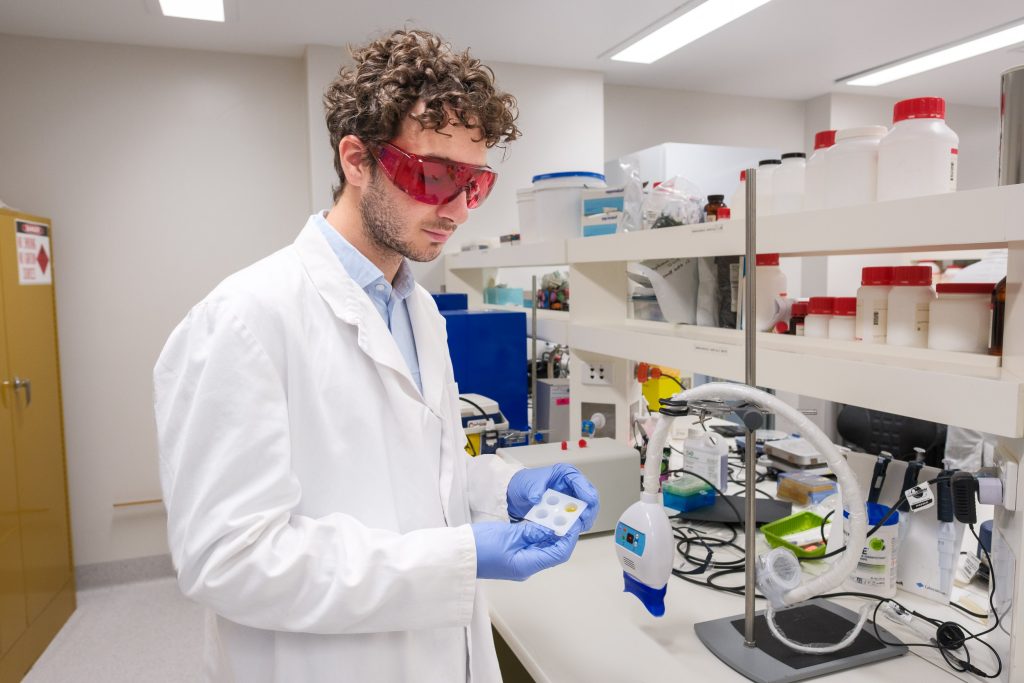Many life changing medicines trace their origins to the animal world. Historically, insulin used to treat diabetes was extracted from the pancreas of pigs or cows. Heparin (blood thinner), widely used to prevent blood clots in surgery and in patients at risk of thrombosis, was first harvested from the intestinal mucosa of pigs or lungs of cattle.
Now, in a quest to find treatments for retinal diseases, QEI scientists are investigating the therapeutic possibilities of sericin, a substance found in silkworm cocoons.
The challenge – combatting vision loss caused by oxidative stress
Retinal diseases such as age-related macular degeneration, retinitis pigmentosa and diabetic retinopathy can be caused by oxidative stress. This damage occurs at a cellular level. When one molecule gives up an electron to another, scientists say it is “oxidized.” Oxidation happens through chemical reactions in our bodies all the time. The process creates “free radicals,” which can break down cell tissue, cause inflammation and even damage our DNA, leading to lifelong diseases.
The eye’s photoreceptor cells (rods and cones) are especially susceptible to oxidative stress because they consume high amounts of oxygen due to their constant activity. They are also exposed to light, which can generate free radicals. Their outer segments contain polyunsaturated fatty acids, which are easily oxidized, and they have high metabolic demands and mitochondrial activity.
Damage or death of photoreceptor cells from oxidative stress can lead to poor vision in dim light, or loss of colour vision or visual sharpness. If enough photoreceptors are damaged, people can experience progressive vision loss and even blindness.
Exploring the anti-oxidative effect of silk sericin
The Queensland Eye Institute is investigating the anti-oxidative effect of silk sericin and its potential to treat retinal diseases as part of its ophthalmic bioengineering and biomaterials research program.
Sericin is a protein found in the silk produced by the silkworm Bombyx mori. It acts as a “glue”, holding together the fibroin fibres that make up a silk cocoon. Silk sericin can be crosslinked, copolymerized and blended with other materials, especially artificial polymers, to produce materials with improved properties.
In earlier research, QEI scientists found that sericin isolated from the cocoons of normal Bombyx mori silkworm did not display anti-oxidative effects. Current projects are studying the effects of sericin isolated from a mutant silkworm produced in Japan known as “Sericin Hope”.

Latest findings for silk sericin
Today, QEI scientists are working on separating and preparing sericin and making materials that contain it. They are growing retinal photoreceptor cells (the light-sensing cells of the eye) on these materials to see how sericin affects them. The tests are done both under normal conditions and under oxidative stress (a type of cell damage linked to eye disease).
Most recently they tested two different forms of sericin to see if they could protect cells from damage caused by oxidative stress.
When tested in the lab (in vitro), a crude extract of sericin (which still contained other natural components from the cocoon) showed antioxidant effects, helping protect mouse retinal cells from damage. However, purified sericin on its own did not show this protective effect in the same lab tests.
When tested in live rodents (in vivo) with a model of retinal injury, both forms of sericin showed antioxidant effects.
These findings suggest that in living organisms, purified sericin may be broken down by metabolism, releasing serine—an amino acid that is a powerful antioxidant on its own. This could explain why purified sericin works in animals but not in cell cultures.
At this stage, this idea remains a hypothesis and needs more research to confirm it.

Read more
The latest publication by QEI researchers on the anti-oxidative effect of silk sericin can be read in this journal: Study of the Antioxidative Effects of Bombyx mori Silk Sericin in Cultures of Murine Retinal Photoreceptor Cells
Earlier findings are published in these journals:
Silk fibroin/sericin native blends as potential biomaterial templates